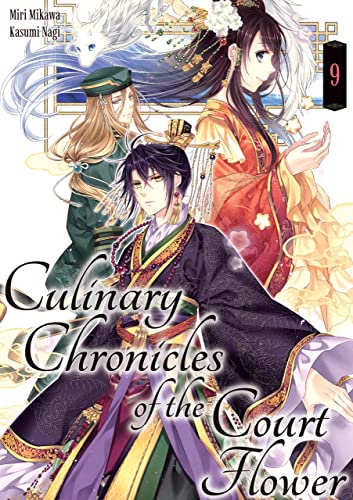By Miri Mikawa and Kasumi Nagi. Released in Japan as “Ikka Kōkyū Ryōrichō” by Kadokawa Beans Bunko. Released in North America digitally by J-Novel Club. Translated by Hunter Prigg and piyo.
I was a fan of Fruits Basket back in the day, when the manga was still running. When we got to the chapters where Yuki and Tohru define their actual relationship, I remember being somewhat baffled at the negative reaction by Yuki/Tohru fans. (Yes, I still use slashes. I’m old.) But of course I didn’t get it, I was a Kyo/Tohru shipper. There’s a reason people ship one pairing and not another, it’s because they don’t GET the other pairing. Now, to be clear, that’s not really what happens with Culinary Chronicles of the Court Flower. I absolutely get Shusei/Rimi, it’s the primary pairing. But the last couple books have had Shohi have to assure both himself and everyone around him that Rimi ends up being just like a mother to him, and I found myself thinking “Ah, yeah, that’s why they were mad”. In the end, there really isn’t a choice between two love interests. It’s fate aligning so that one love interest can win and nothing else matters.
We begin with the action-packed finale, as Shohi’s forces do battle against Shusei’s forces, who (no surprise) turn out to have far more men than everyone thought. Fortunately, things work out for two reasons. One, the consorts finally realize what the Quinary Dragon thing means, and two, reinforcements arrive from Saisakoku out of nowhere, having been told to come by… well, gosh, it’s a mystery. After all of this, unfortunately, they do sort of have to execute Shusei, who was behind the entire traitorous revolt. That said, they immediately begin to waffle when it turns out that Shusei was in fact behind the ENTIRE traitorous result. On both sides. Meaning they’ve caught up with the reader, who probably realized what Shusei was doing a few books ago.
Despite my gripes, this is a decent finale. Rimi’s feelings for Shusei had been cast away as she was certain that “Lord Ho” had killed the Shusei she knew; once she realizes that it was all a massive trick, they come roaring back full force. Shohi will have to content himself with 2.5 of the 4 consorts (Ho is still going to remain loyal to Hakurei, and Yo hates men, but is starting to waffle). As for the solution of how to get out of the execution, it’s pretty clever, and relies very much on one of the past mysteries of the series also requiring a definitive execution to end it. I also liked hearing of Saigu near the end. Rimi’s one touchstone from her old country has never been seen in the series, but her presence has influenced Rimi’s maturation greatly. Still, I think the best part of the book was Keiyu, whose last middle finger to everyone was very clever.
So yeah, the shipper in me is grumbling, as I felt Shusei burnt too many bridges to have Rimi forgive him so easily. But that’s first love for you, I guess. In the end, I enjoyed this series about romance, mystery, and food.










